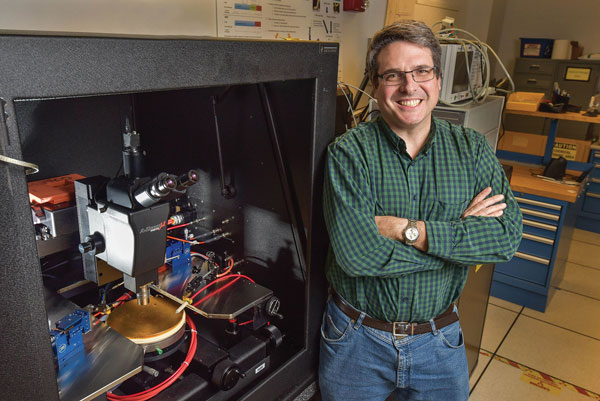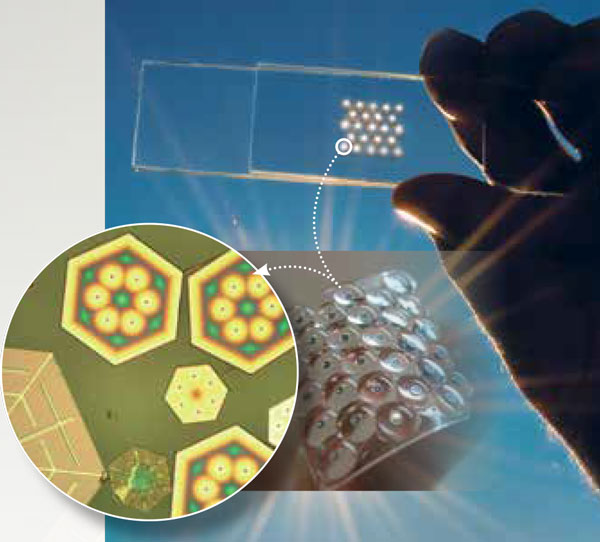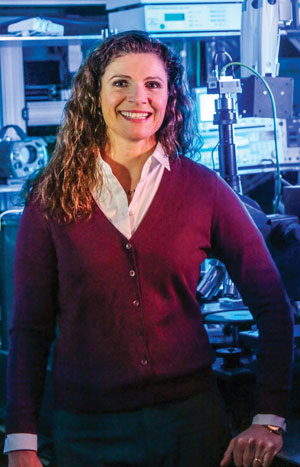The world wants smaller, lighter, more efficient power systems - electricity where it's needed, when it's needed. A tall order, but the payoff would be huge.

Sandia National Laboratories wants to invent the electrical future.
The modern world runs on electricity. But the power needs of an electrical grid to serve a large city are not the same as those of a sensor placed in the middle of nowhere to detect intruders.
Sandia formed its Power on Demand Research Challenge about three years ago, building on work the labs had done for decades in everything from semiconductors to materials science. Olga Spahn, Semiconductor Material and Device Sciences manager, calls the Research Challenge a coalition of the willing that also acts as a matchmaker between technologies and users.
The idea is to accelerate revolutionary technologies that will form the backbone of the electrical power systems of the future: exponentially increasing the speed, efficiency and performance of electrical power systems while decreasing their size and weight and therefore cost.
“The key to Power on Demand is to say: ‘Science could have an impact; let’s work on this,’” says Radiation and Electrical Sciences Director Charles Barbour. Goals include developing advanced semiconductor materials and devices, and improving batteries while helping solve research questions for Sandia’s critical national security work.
Research Challenges are long-range projects — in this case, 10 to 15 years — that draw from multiple fields to respond to wide-ranging, important questions.
The civilian world wants secure and sustainable electrical sources for everything from transportation to large-scale power generation, while the defense realm has power needs ranging from electric ships to satellites. Both want smaller, lighter and more efficient electrical power systems providing electricity when they want it and in the form they need.
Smaller, more powerful electrical systems
Power on Demand aims to develop electrical power systems with the smallest size and weight for the largest possible amount of energy, what’s known as SWaP, for size, weight and power. That requires tackling underlying fundamental science questions and complicated technical demands to make better devices, materials and power systems.
The payoff could be huge — an efficient and smart next-generation power grid, better electrical motors for industry, energy storage and conversion for renewable power, better battery technologies for electric and hybrid vehicles, autonomous sensors in remote locations, electricity for forward-operating military bases, extended robotics lifespans, more efficient nuclear weapons subsystems hardened against damage from radiation, and compact, reliable and radiation-hardened power conversion systems for satellites.
Sandia’s Power on Demand Research Challenge is divided into three technology focus areas: high-density storage of electrical energy in extreme environments (special batteries); ultracompact power electronics (wide and ultrawide bandgap semiconductors); and high-efficiency, low-weight harvesting of spectral energy (microsystems-enabled photovoltaics). Another area cross-cuts these three to address how to integrate storage, switching and distribution into different types of systems. It includes issues such as balancing power across asynchronous systems that require both steady power and pulsed power in a single system.

How everything fits together
“The three technology focus areas highlight differ-ent aspects,” Spahn says. “We think about a system’s pieces, how they all go together.”
The first focus area, battery-based energy storage, explores battery-powered, high-performance electrical energy storage for mobile power and pulsed power applications.
Researchers in the second focus area are looking both at wide bandgap and ultrawide bandgap advanced semiconductor materials for power electronics that will allow electricity to be distributed where it’s needed with smaller, lighter and more efficient power converters. Power electronics are vital for electrical systems because they transfer power from a source to the load, the user, by converting volt-ages, currents and frequencies.
Sandia in the past year sponsored two ultrawide bandgap material and device workshops, one in Albuquerque and one near Washington, D.C. A roadmap that outlines research needs was developed as a result of these meetings, says Sandia Fellow Jerry Simmons, a long-time researcher in semiconductor materials.
The challenge’s third technology focus, microscale photovoltaics, is studying wireless power transfer by what’s known as microsystems-enabled photovoltaics, with the goal of transmitting electricity across free space more efficiently.
The work got a head start through a microsystems-enabled photovoltaics (MEPV) Laboratory Directed Research and Development (LDRD) Grand Challenge that wrapped up in 2014. MEPV uses microdesign and fabrication techniques to make tiny solar cells that are released into a solution similar to ink, which is “printed” onto a substrate with embedded contacts and mini-lenses to focus sunlight onto the cells. The tiny, thin cells reduce the cost of materials while improving generation. They have potential uses in buildings, vehicles and portable electronics. An especially compelling use is in satellite applications, which need to harvest photovoltaic energy at the lowest possible weight.
Projects link technologies
Power on Demand also has three different central, major demonstration projects, each of which ties the three focus area technologies together and encompasses related research and development projects, some of which are funded by Sandia’s LDRD program. The demonstration projects pull researchers from diverse fields all over Sandia to work together.
The first demonstration project, mobile pulsed power, will develop portable power systems that can store, switch and distribute baseline power loads but also can handle short, high-power pulses without damaging or disrupting other loads in the system. “We have to think about how to do combined [types of power] which we can’t do now,” Barbour says.
Success will require improving and integrating technologies in energy storage and power electronics; developing new materials; shrinking all parts of a circuit, including capacitors and inductors; and improving overall delivery systems and controls, Spahn and Simmons say.
The second demonstration project centers on an alternative bus-based power distribution for nuclear weapons to reduce costs and increase radiation resistance and reliability in harsh environments. Power buses manage electrical power distribution that allows modularity in the weapon. The demonstration project is being undertaken in a new Grand Challenge LDRD project, “Enabling Modular Architectures with Radiation-Hard Bus-Based Power Delivery,” under principal investigator Jason Neely in Sandia’s Radiation and Electrical Sciences Center.
The third demonstration project involves remote sensing for site security. Researchers want to develop a power system that would enable remote power delivery to a network of sensors, requiring a targeted design of an energy source and storage, power conversion and distribution. It would use microsystems-enabled photovoltaics to provide power in far-flung locations, with the photovoltaics contoured to fit their environment. In addition, the sensor’s batteries potentially could be recharged by beaming power from another location.
“They could reconfigure themselves, communicate with each other and call home when they sense something,” Simmons says. Similar capabilities also would be useful for satellites.
Sandia’s long-term goal for the Power on Demand Research Challenge is nothing less than enabling a revolution in electrical power technology. While the existing demonstration projects all encompass national security needs, future demonstrations could involve civilian energy. “The nation’s electrical grid, and its resilience against weather events and solar electrical storms, is getting increased attention by Congress,” says Barbour. “We think the technologies we’re developing in Power on Demand can help with that problem, too. It may be our next demonstration project.”

Meet Olga Spahn
When Olga Spahn isn’t working on optical and microelectronics research at Sandia, she can be found hanging out with her family and with other scientists. She rides with the Penultimates, a bike team with a membership that’s 98 percent Sandians, and trains for triathlons, road bike races and the MS150 held at summer’s end. She describes the MS150 as a two-day, 150-mile trek that benefits muscular dystrophy and allows her to “enjoy the beautiful scenery of New Mexico, food, camaraderie, mutual suffering and the workout.”

Spahn manages Sandia’s Semiconductor Material and Device Sciences department, and has done research in optical and microelectronics at the labs for 23 years. She’s a program manager for the Ultrawide Bandgap Power Electronics Grand Challenge Laboratory Directed Research and Development project and a deputy for Sandia’s Power on Demand Research Challenge.
She sees compound semiconductors as an exciting area of research.
“My passion is connecting this unique, differentiating technology with program needs and executing both the science and the application to profoundly impact our national security missions,” she says.
Her research has spanned a large variety of topics, including development of optical trapping, laser cutting and automation for particle forensic applications, laser-induced plasmas as analogues of macroscale explosive phenomena, characterization of laser welding and additive manufacturing processes. She also has worked on microelectromechanical systems (MEMS)/photonics integration and optical effects in MEMS, microfabrication of compound semiconductor optoelectronic devices such as lasers, modulators and detectors, and integrating them into microsystems.
— Sue Major Holmes